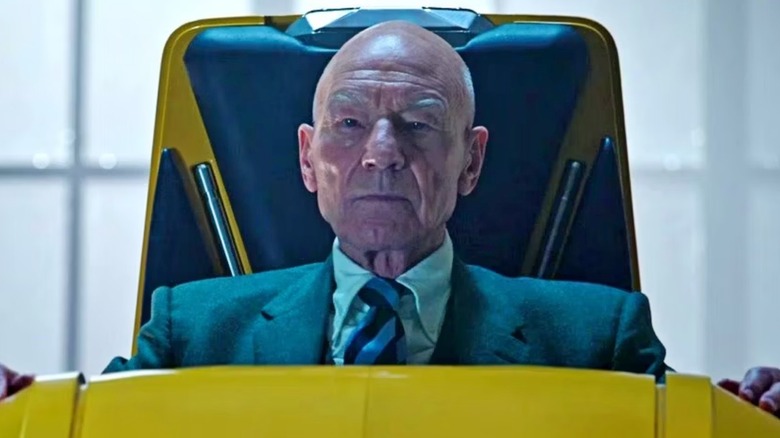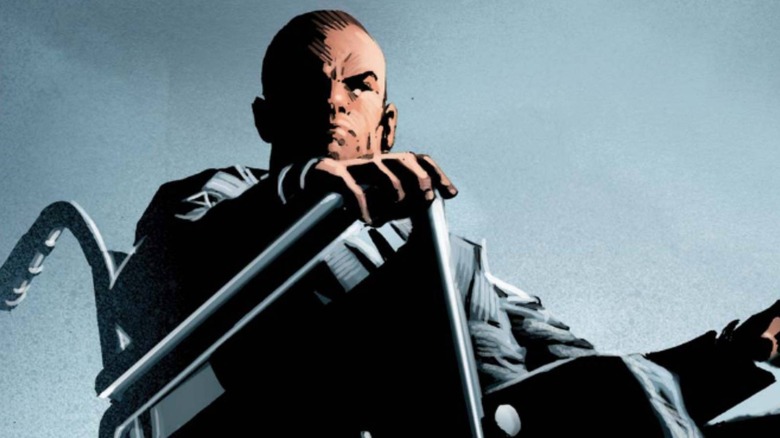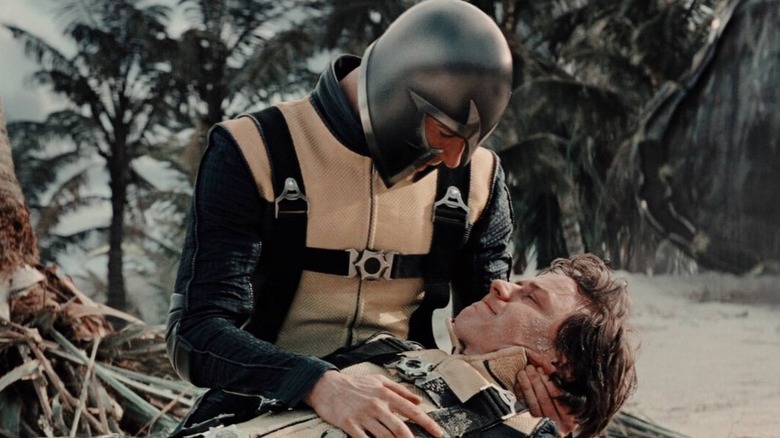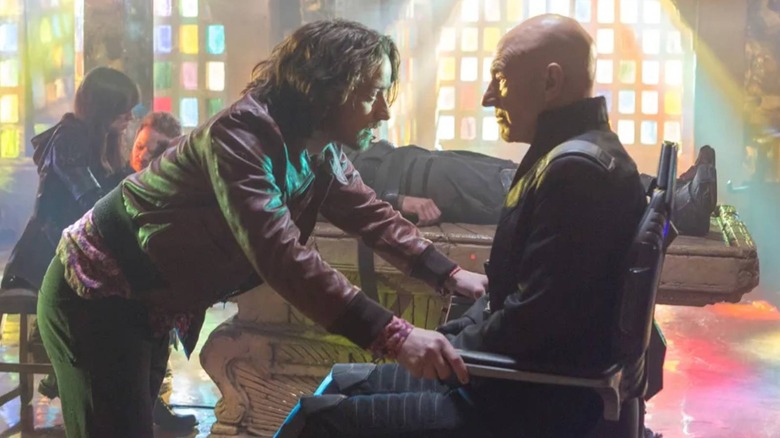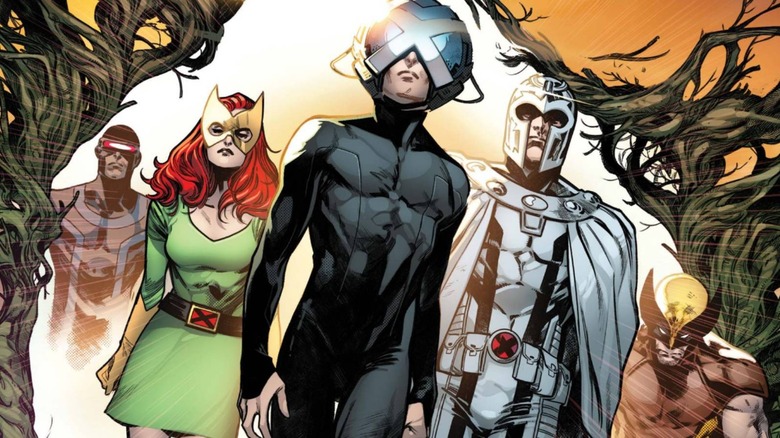Why Professor X Can't Walk, Explained
While some mutants are better known for popping knives out of their knuckles or turning into solid ice, one guy turns the tide whenever he puts his fingers to his temple and squints really intensely. Charles Xavier, aka Professor X, is a force to be reckoned with and comes with a complex backstory of frenemies and treachery.
One of the defining events of the professor's life, of course, is when he loses the ability to walk, the origins of which have been altered in various iterations of his story. No matter which version has crossed fans' radars, however, there's always been an air of tragedy about the incident: while changing his life forever, it also made him an even stronger character.
But what was it that put Professor X in his wheelchair and how was it presented in the films that brought the X-Men from the comics to the screen? Casual fans — who aren't up to date on all the exploits of the mutant superteam — may also wonder why Charles never uses his powers to address the issue in the movies, even as he possesses the ability to walk in the more recent comics. Well, gather round, youngsters (gifted or not), and let's discuss the event that was integral to making Professor X the comic book icon he is today.
Why couldn't Professor X walk in Marvel comics?
He might be one of the most powerful mutants on the planet, but it's actually an otherworldly entity that takes away Professor X's ability to walk. As revealed in "Uncanny X-Men" #20, a story set long before Charles opened his school as a safe haven for mutants, an encounter with an alien named Lucifer leads to the life-altering injury. At a time when Charles is a fairly athletic and fit young man, his powers catch the attention of this mysterious enemy while he's traveling through Tibet.
As Lucifer preps for an invasion of Earth, Charles leads the local townsfolk in a revolt to overthrow the alien's base and take back their land. In an effort to stop Lucifer from fleeing, Charles chases him down, only to fall victim to one of his enemy's traps. A giant stone block falls on Charles's legs, leaving him paralyzed. While this has a damaging impact on Professor X, it also leads the powerful telepath to establish the X-Men as a safety precaution for whenever Lucifer returns.
While that tale might be a little out there in terms of what was a pivotal moment in the life of Professor X, the origin of Charles' injury in the big screen "X-Men" franchise is much more tragic. It would also be far more impactful if it wasn't part of such an inconsistent film series that undermines the incident right in one of the movies.
Why Charles Xavier couldn't walk in the X-Men movies
It's Charles' longtime frenemy, Erik Lensherr (aka Magneto), who is responsible for the professor's paralysis in the the "X-Men" movie timeline.
One of the best "X-Men" movies to date, "X-Men: First Class" chronicles the early stages of the relationship between Charles (James McAvoy) and Erik (Michael Fassbender) and the development of the titular team. While their alliance always has the potential to bloom into a great partnership, Erik and Charles' friendship reaches the breaking point when Magneto decides to fight back against the human military and, in doing so, accidentally deflects a bullet aimed for him that lodges in Charles' spine.
It's a detail that adds even more heft to the friendship that was first introduced through Patrick Stewart and Ian McKellen's performances in 2000's "X-Men" and fortified by the younger stars that took on the roles. What undercuts it, unfortunately, is the odd explanation in the follow-up, "X-Men: Days of Future Past," which sees Xavier able to walk again via nullifying his powers. The reason why his telepathic powers being quelled would reverse a severe spinal injury is only skimmed over, although it's a little easier to process than the various explanations for him walking again in the comics.
What can't Charles Xavier move his legs with his mind?
He might have been part of the Marvel universe since 1963, but some folks who aren't invested in the mutant mythology still don't know why Charles Xavier can't use his incredible powers to cure himself of his ailment. The reason is that Professor X is a telepath, giving him the ability to both read and control people's minds, which is where his abilities end. He unfortunately doesn't possess telekinesis, a power that allows the individual to move things with their mind, much like the skills that Jean Grey has.
While everything from cloning to medical aid to the bending of reality itself has allowed Charles to walk, these events have often been undone thanks to injuries or double-crosses that have put him back in his iconic wheelchair. Recently though, Charles has spent a lot of time on his feet, thanks to the tumultuous Krakoan Age and the events that take place on the mutants' sacred and secluded island.
Why can Professor X walk again?
At this point in Marvel comics, Charles Xavier has died as many times he's been in a wheelchair. But his most recent and lengthy period of being up and about stretches back to "House of M," when Wanda Maximoff alters reality and give him the ability to walk. This continues up until 2012 and "Avengers vs. X-Men," when Charles is killed. From there, his consciousness is transferred into the body of Fantomex and he's once again able to walk. At that point, Charles, the X-Men, and the rest of mutantkind enter the Krakoan Era, during which dead mutants are able to live again thanks to the Resurrection Protocols. This allows him to return from the brink in a body that once again can move on two legs.
Unfortunately, Charles' dream of paradise ends following the events of "Fall of X," leading the founder of the X-Men to make deals with the enemy and inadvertently put an end to his mutant sanctuary. Now still held captive of his own volition, there's no telling if and when Charles will return to his X-Men, or whether he'll be in his wheelchair once more.
